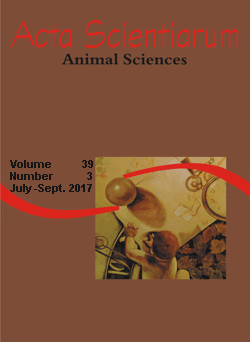<b>Production and chemical composition of grasses and legumes cultivated in pure form, mixed or in consortium
Abstract
The objective of this study was to assess the edible biomass and chemical composition of forages grown on pure form, as a grass mix, and in grass-legume consortia. The following species were tested: white oats (Avena sativa), black oats (Avena strigosa), ryegrass (Lolium multiflorum), forage peanut (Arachis pintoi), white clover (Trifolium repens), and red clover (Trifolium pratense). The experiment consisted of sixteen treatments arranged in a completely randomized design. The parameters measured were total dry matter (PMST), neutral detergent fiber (NDF), acid detergent fiber (ADF), and crude protein (CP). No significant differences in PMST were found among the consortia (p > 0.05). Only the pure cultivated white clover (p > 0.05) was comparable to the consortia in terms of biomass production. The three legumes had the lowest average NDF values (p > 0.05), based on their contributions to the total NDF content of the consortia along the cuts. The ADF content increased for all treatments during the cuts. The results indicate that in pasture, legumes increase protein content, and forage consortia increase both the pasture production and the grazing period. Their chemical composition is adequate for boosting livestock production in pastures.
Downloads
DECLARATION OF ORIGINALITY AND COPYRIGHTS
- I Declare that current article is original and has not been submitted for publication, in part or in whole, to any other national or international journal.
The copyrights belong exclusively to the authors. Published content is licensed under Creative Commons Attribution 4.0 (CC BY 4.0) guidelines, which allows sharing (copy and distribution of the material in any medium or format) and adaptation (remix, transform, and build upon the material) for any purpose, even commercially, under the terms of attribution.
Read this link for further information on how to use CC BY 4.0 properly.








































